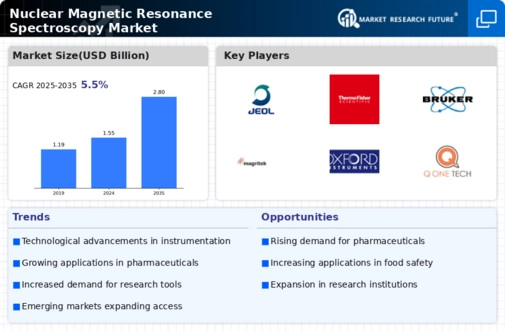Market Analysis
In-depth Analysis of Nuclear Magnetic Resonance Spectroscopy Market Industry Landscape
This is a dynamic and ever-changing market driven by factors that influence the adoption, development, and application of NMR spectroscopy technology. Scientific research trends, technological advancements, regulatory considerations, competitive forces, and the broader landscape of analytical instrumentation all shape the market dynamics in this area.
The Nuclear Magnetic Resonance Spectroscopy Market is heavily influenced by scientific research trends and applications. NMR spectroscopy has many uses in academic and industrial laboratories to determine the structure and dynamics of molecules which makes it an invaluable tool for studying materials science chemistry or biochemistry. The need to come up with better tools in research coupled with a demand for advanced techniques underpin the continuous growth as well as innovation witnessed in the sector.
Technological advances are one of the major drivers behind the NMR Spectroscopy Market’s dynamics. Ongoing developments in magnet technology, probe design, and software capabilities improve sensitivity, resolution and speed of NMR experiments. Through these advancements, performance standards for NMR instruments have been improved while at the same time opening new vistas whose frontiers lay in drug discovery metabolomics as well as structural biology.
Regulatory issues are important determinants of NMR Spectroscopy market dynamics. In industries such as pharmaceuticals, biotech companies or food & beverage sectors compliance with quality control systems including safety standards affects manufacturing and design process for NMRI machines. By adhering to regulatory requirements data reproducibility is ensured thereby enhancing acceptance of data generated through nuclear magnetic reasonance spectroscopy within regulated environments.
NMR Spectroscopy has competitive forces among manufacturers shaping its dynamics. Factors like instrument performance user friendly interfaces (UFI) among others help manufacturers differentiate their products from others’. This necessitates M&As Collaborations Alliances partnerships etc which are common strategies employed by manufactures seeking to expand their product portfolios hence remain competitive.
Market Dynamics Are Shaped by Broader Landscape of Analytical Instrumentation Too. These include mass spectrometry and chromatography which are some of the alternatives to NMR spectroscopy in various industries. The method chosen for analysis will depend on nature of the sample, sensitivity levels required among others thus making analytical instruments highly competitive.
Economic factors such as research funding and budgetary considerations can affect the adoption of NMR spectroscopy technology. Demand for advanced analytical tools is driven by investment in research and development both in academia and industry. In addition, economic conditions and budget constraints may impact the purchasing decisions of research institutions and companies thereby affecting overall growth within the Nuclear Magnetic Resonance Spectroscopy Market.










Leave a Comment